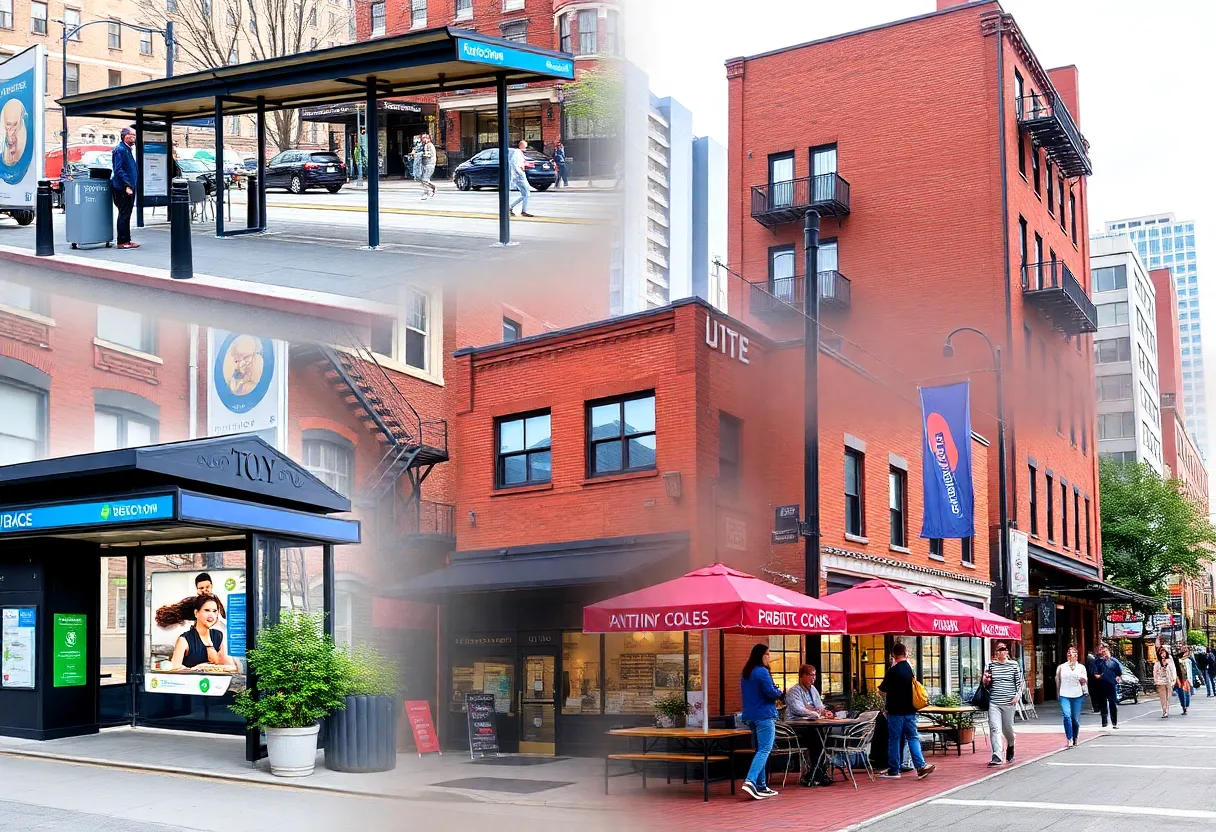Boston, September 23, 2025
Explore Boston’s top neighborhoods for seamless public transit access. From the upscale charm of Back Bay to the vibrant arts scene in Somerville, find out where young professionals and commuters are thriving. Learn about the best spots for convenience, community vibes, and lifestyle in this comprehensive guide on living near the T. Discover which areas provide the best balance of affordability and transit options while ensuring a lively neighborhood atmosphere.
Boston’s Transit Hotspots: Where to Live If You Want the T at Your Doorstep
If you’re in Boston or planning a visit and want a neighborhood that gets you around without a car, listen up. I walked these streets, rode the trains, peeked into coffee shops, and kept score like a neighborhood gossip columnist. Here’s a lively, no-nonsense guide to the best Boston spots for young professionals, commuters, and curious visitors who demand fast, frequent public transit and a lively neighborhood vibe.
Back Bay
Stylish brownstones, window-shopping on Newbury, and stunning views of the river make Back Bay irresistible. You’ll find quick access to the T at both Copley and Back Bay stations, which means downtown commutes are a breeze. Perfect for those who like upscale surroundings and a short walk to work.
South End
The South End is trendy and compact, full of Victorian charm, restaurants, and galleries. With access to the Orange and Green Lines, this neighborhood is ideal if you want to be central but still feel like you live in a cool, artsy enclave.
Fenway-Kenmore
Home to major universities and cultural venues, Fenway-Kenmore buzzes with energy. The Green Line runs through, so downtown is quick and easy — plus there are bars and late-night spots for when the shift ends and the fun begins.
Cambridge
Across the river and always alive with ideas, Cambridge (think Harvard and MIT neighborhoods) is a hub of innovation. The Red Line connects key squares like Kendall and Central to downtown, making it a favorite for those who work in the city but want a slightly different scene.
Somerville
Davis Square and Union Square bring a creative, community-first vibe to Somerville. With Red Line access and the Green Line Extension, getting into Boston is easy — and the local arts and food scenes are worth the trip alone.
Allston-Brighton
Young, loud, and more affordable than many parts of Boston, Allston-Brighton is a magnet for students and entry-level professionals. The Green Line B branch runs through Commonwealth Avenue, keeping options open for transit and nightlife.
Brookline & Coolidge Corner
Brookline blends historic charm with modern living. Coolidge Corner is the cultural hub with Green Line access — a smooth ride to the heart of the city and plenty of neighborhood perks like indie shops and cozy cafes.
Jamaica Plain (JP) & Forest Hills
JP offers green spaces and an artsy vibe, plus Orange Line access. Forest Hills brings suburban calm within city limits and solid transit connections for those who want trees on their commute.
Seaport District
If you want modern high-rises, waterfront views, and luxury amenities, the Seaport is the place to be. The Silver Line and quick rideshares put you close to downtown — expect newer buildings, co-working spaces, and a buzzy after-work scene.
North End, Bay Village, Chinatown, West End
These central neighborhoods offer top-tier transit access — some boast a Transit Score of 100 — making them ridiculously easy for walking, buses, and T connections. Food, history, and nightlife are all right outside your door.
Outlying but Connected: Uphams Corner, Waltham, Hyde Park, Mattapan, West Roxbury
Looking for more space or lower rent? Consider spots like Uphams Corner on the Fairmount Line, Waltham to the west, or Hyde Park and West Roxbury for a suburban feel with commuter rail and bus options. Mattapan has trolley connections that feed into the Red Line corridor.
Price Snapshots & Reality Check
Neighborhood prices vary wildly. Some areas like Allston-Brighton and Hyde Park trend more affordable, while Seaport and parts of South Boston have higher price tags — with certain neighborhoods showing median home prices well into six figures for entry-level buyers. Transit convenience often comes with a premium, but it pays back in saved time and less car hassle.
Quick Tips for Transit-Focused Living
- Check the Transit Lines: Pick a neighborhood near the T line you’ll use most.
- Walkability Matters: If you love coffee shops and late-night snacks, choose a walkable neighborhood.
- Think About Commute Time: A 20-minute subway ride beats a 45-minute drive any day.
- Budget for Convenience: Transit-rich spots often cost more; decide what you’ll prioritize.
Final Verdict
If you live in Boston or plan to visit, there’s no shortage of neighborhoods where public transit opens up your life. From ultra-central spots with perfect transit scores to quieter, commuter-friendly outposts, you can pick a place that fits your wallet and your lifestyle. Pack a MetroCard, lace up your walking shoes, and get ready to explore — Boston’s T will take you almost anywhere.
FAQ
Q: Which Boston neighborhoods have the best public transit access?
A: Central neighborhoods like Bay Village, Chinatown-Leather District, and the West End have top transit access with very high Transit Scores. Fenway, Back Bay, South End, Cambridge, and the Seaport also offer excellent connections via the T and bus routes.
Q: Is the Seaport a good choice for young professionals?
A: Yes, if you want modern apartment living, waterfront amenities, and a short commute by Silver Line or rideshare. It tends to be pricier than some other neighborhoods.
Q: What are affordable transit-friendly neighborhoods?
A: Neighborhoods like Allston-Brighton, Hyde Park, and parts of Jamaica Plain, Mattapan, and Uphams Corner often offer more budget-friendly housing while still providing decent transit options.
Q: Should I choose a neighborhood based on a single T line?
A: Consider your daily routes. Picking a spot close to the line that serves your work or school makes life simpler, but having access to multiple lines or reliable bus routes adds flexibility.
{
“@context”: “https://schema.org”,
“@type”: “FAQPage”,
“mainEntity”: [
{
“@type”: “Question”,
“name”: “Which Boston neighborhoods have the best public transit access?”,
“acceptedAnswer”: {
“@type”: “Answer”,
“text”: “Central neighborhoods like Bay Village, Chinatown-Leather District, and the West End have top transit access with very high Transit Scores. Fenway, Back Bay, South End, Cambridge, and the Seaport also offer excellent connections via the T and bus routes.”
}
},
{
“@type”: “Question”,
“name”: “Is the Seaport a good choice for young professionals?”,
“acceptedAnswer”: {
“@type”: “Answer”,
“text”: “Yes, if you want modern apartment living, waterfront amenities, and a short commute by Silver Line or rideshare. It tends to be pricier than some other neighborhoods.”
}
},
{
“@type”: “Question”,
“name”: “What are affordable transit-friendly neighborhoods?”,
“acceptedAnswer”: {
“@type”: “Answer”,
“text”: “Neighborhoods like Allston-Brighton, Hyde Park, and parts of Jamaica Plain, Mattapan, and Uphams Corner often offer more budget-friendly housing while still providing decent transit options.”
}
},
{
“@type”: “Question”,
“name”: “Should I choose a neighborhood based on a single T line?”,
“acceptedAnswer”: {
“@type”: “Answer”,
“text”: “Consider your daily routes. Picking a spot close to the line that serves your work or school makes life simpler, but having access to multiple lines or reliable bus routes adds flexibility.”
}
}
]
}
Neighborhood Transit & Feature Chart
| Neighborhood | Main Transit | Vibe | Price Note |
|---|---|---|---|
| Back Bay | Copley & Back Bay (T) | Upscale, walkable | Higher-end |
| South End | Orange & Green Lines | Trendy, artsy | Mid to high |
| Fenway-Kenmore | Green Line | Vibrant, college energy | Mid |
| Cambridge | Red Line | Academic, innovative | Varies (popular & pricey areas) |
| Somerville | Red Line & GLX | Creative, community-focused | Mid |
| Allston-Brighton | Green Line B branch | Studenty, affordable | Median home price example: $749K (as of June 2025) |
| Seaport | Silver Line & rideshare | Modern, luxury | High |
| Bay Village / Chinatown / West End | Multiple lines; Transit Score 100 | Ultra-central, dense | Varies (central premium) |
| Outskirts (Hyde Park, Waltham, West Roxbury) | Commuter Rail & buses | Suburban feel, more space | More affordable options |
Deeper Dive: News & Info About This Topic
HERE Resources
How To Choose The Right Boston Neighborhood For Families
Ed Flynn Introduces Resolution Against Safe Injection Sites in Boston
Boston’s Mass. and Cass Area Shows Signs of Change Amid Concerns
Family-Friendly Halloween Events in Greater Boston
Republic Services Strike Comes to an End After 81 Days
Springfield Mayor Calls for Strict Penalties After Drive-By Shootings
Federal Funding Canceled for Boston Transportation Projects
Boston Opens Nominations for Legacy Business Awards
Boston Faces Rising Rental Vacancies Amid Declining International Students
Mayor Wu Proposes 700-Foot Skyscrapers for Downtown Boston
Author: STAFF HERE BOSTON WRITER
The BOSTON STAFF WRITER represents the experienced team at HEREBoston.com, your go-to source for actionable local news and information in Boston, Suffolk County, and beyond. Specializing in "news you can use," we cover essential topics like product reviews for personal and business needs, local business directories, politics, real estate trends, neighborhood insights, and state news affecting the area—with deep expertise drawn from years of dedicated reporting and strong community input, including local press releases and business updates. We deliver top reporting on high-value events such as Boston Marathon, Head of the Charles Regatta, and Boston Harborfest. Our coverage extends to key organizations like the Greater Boston Chamber of Commerce and Associated Industries of Massachusetts, plus leading businesses in finance, biotech, and insurance that power the local economy such as Fidelity Investments, Biogen, and Liberty Mutual Insurance. As part of the broader HERE network, we provide comprehensive, credible insights into Massachusetts's dynamic landscape.





